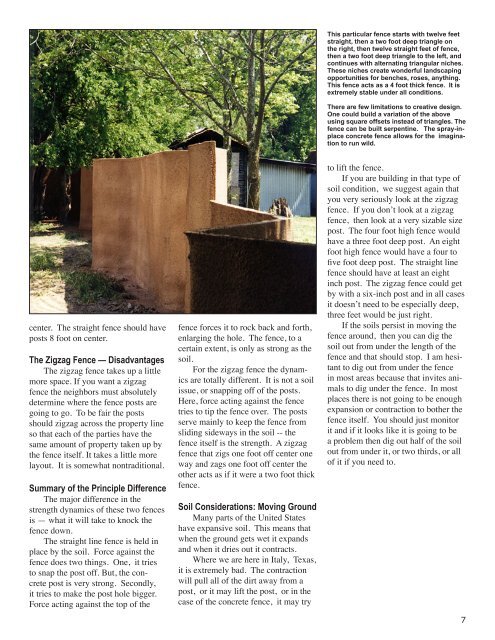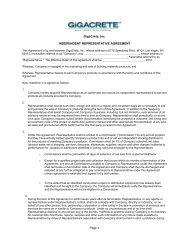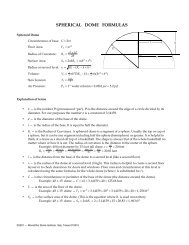How To Build A Spray-In-Place Concrete Fence - Monolithic
How To Build A Spray-In-Place Concrete Fence - Monolithic
How To Build A Spray-In-Place Concrete Fence - Monolithic
Create successful ePaper yourself
Turn your PDF publications into a flip-book with our unique Google optimized e-Paper software.
This particular fence starts with twelve feet<br />
straight, then a two foot deep triangle on<br />
the right, then twelve straight feet of fence,<br />
then a two foot deep triangle to the left, and<br />
continues with alternating triangular niches.<br />
These niches create wonderful landscaping<br />
opportunities for benches, roses, anything.<br />
This fence acts as a 4 foot thick fence. It is<br />
extremely stable under all conditions.<br />
There are few limitations to creative design.<br />
One could build a variation of the above<br />
using square offsets instead of triangles. The<br />
fence can be built serpentine. The spray-inplace<br />
concrete fence allows for the imagination<br />
to run wild.<br />
center. The straight fence should have<br />
posts 8 foot on center.<br />
The Zigzag <strong>Fence</strong> — Disadvantages<br />
The zigzag fence takes up a little<br />
more space. If you want a zigzag<br />
fence the neighbors must absolutely<br />
determine where the fence posts are<br />
going to go. <strong>To</strong> be fair the posts<br />
should zigzag across the property line<br />
so that each of the parties have the<br />
same amount of property taken up by<br />
the fence itself. It takes a little more<br />
layout. It is somewhat nontraditional.<br />
Summary of the Principle Difference<br />
The major difference in the<br />
strength dynamics of these two fences<br />
is — what it will take to knock the<br />
fence down.<br />
The straight line fence is held in<br />
place by the soil. Force against the<br />
fence does two things. One, it tries<br />
to snap the post off. But, the concrete<br />
post is very strong. Secondly,<br />
it tries to make the post hole bigger.<br />
Force acting against the top of the<br />
fence forces it to rock back and forth,<br />
enlarging the hole. The fence, to a<br />
certain extent, is only as strong as the<br />
soil.<br />
For the zigzag fence the dynamics<br />
are totally different. It is not a soil<br />
issue, or snapping off of the posts.<br />
Here, force acting against the fence<br />
tries to tip the fence over. The posts<br />
serve mainly to keep the fence from<br />
sliding sideways in the soil -- the<br />
fence itself is the strength. A zigzag<br />
fence that zigs one foot off center one<br />
way and zags one foot off center the<br />
other acts as if it were a two foot thick<br />
fence.<br />
Soil Considerations: Moving Ground<br />
Many parts of the United States<br />
have expansive soil. This means that<br />
when the ground gets wet it expands<br />
and when it dries out it contracts.<br />
Where we are here in Italy, Texas,<br />
it is extremely bad. The contraction<br />
will pull all of the dirt away from a<br />
post, or it may lift the post, or in the<br />
case of the concrete fence, it may try<br />
to lift the fence.<br />
If you are building in that type of<br />
soil condition, we suggest again that<br />
you very seriously look at the zigzag<br />
fence. If you don’t look at a zigzag<br />
fence, then look at a very sizable size<br />
post. The four foot high fence would<br />
have a three foot deep post. An eight<br />
foot high fence would have a four to<br />
five foot deep post. The straight line<br />
fence should have at least an eight<br />
inch post. The zigzag fence could get<br />
by with a six-inch post and in all cases<br />
it doesn’t need to be especially deep,<br />
three feet would be just right.<br />
If the soils persist in moving the<br />
fence around, then you can dig the<br />
soil out from under the length of the<br />
fence and that should stop. I am hesitant<br />
to dig out from under the fence<br />
in most areas because that invites animals<br />
to dig under the fence. <strong>In</strong> most<br />
places there is not going to be enough<br />
expansion or contraction to bother the<br />
fence itself. You should just monitor<br />
it and if it looks like it is going to be<br />
a problem then dig out half of the soil<br />
out from under it, or two thirds, or all<br />
of it if you need to.<br />
7












